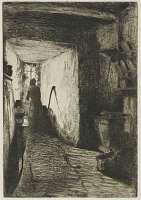Etchings Institutions search term: british museum
The Kitchen | ||
| Number: | 16 | |
| Date: | 1858 | |
| Medium: | etching | |
| Size: | 227 x 157 mm | |
| Signed: | 'Whistler' at lower right | |
| Inscribed: | 'Imp. Delatre. Rue St. Jacques. 171.' at lower right (2); partly removed (3) | |
| Set/Publication: | 'French Set', 1858; Fine Art Society, 1885 (3) | |
| No. of States: | 3 | |
| Known impressions: | 67 | |
| Catalogues: | K.24; M.24; T.13; W.19 | |
| Impressions taken from this plate (67) | ||
KEYWORD
TITLE
'The Kitchen' (1858, Whistler). 1
Possibly 'Saverne' (1874, Pall Mall Galleries). 2
'The Kitchen' (1874, Ralph Thomas, Jr (1840-1876)). 3
This title 'The Kitchen' was consistently used by Whistler and by subsequent cataloguers.
However, it is possible that Whistler might originally have considered different - and contradictory - titles, given the title in his one-man show of 1874, and on the drawing upon which the etching is based, Cuisine à Lûtzelbourg [m0232].
1: Douze eaux-fortes d'après Nature.
2: London Pall Mall 1874 (cat. no. 26).
3: Thomas 1874 (cat. no. 13).
DESCRIPTION
SITTER
SITE
4: 'Mr Whistler's Etchings', The Builder, 5 July 1874 (in GUL PC1/73).
DISCUSSION
5: Lochnan 1984 , pp. 41-3.
6: MacDonald 1995 (cat. nos. 235, 272).


